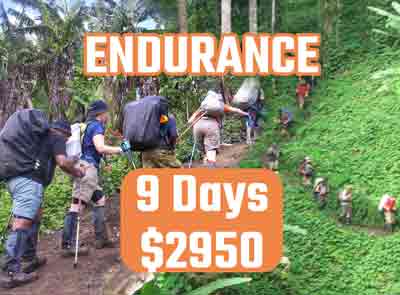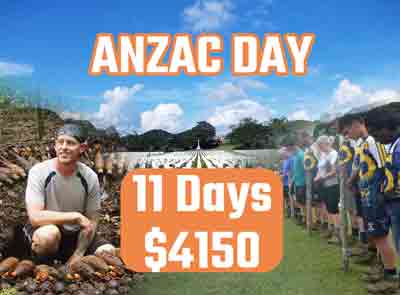A Casualty of the Kokoda Track Campaign: Wartime and Modern Day Deaths on the Kokoda Trail
Introduction
The Kokoda Track, a challenging and historic trek in Papua New Guinea, holds a significant place in Australian military history. As prospective trekkers prepare for the adventure of a lifetime, it’s crucial to delve into the wartime events that unfolded along the Kokoda Trail during 1942. This comprehensive guide aims to provide insights into the conditions, battles, and sacrifices endured by Australian soldiers and their allies. Additionally, we’ll explore the present-day trekking experience, ensuring a holistic understanding for those embarking on this remarkable journey.
Historical Context: The Kokoda Trail Campaign for the Australian Army in Papua New Guinea
Battle of the Coral Sea (July 1942)
The Kokoda Track Campaign was a pivotal theater of war during the Second World War. In July 1942, Japanese forces sought to capture Port Moresby in Papua New Guinea, initiating the Battle of the Coral Sea. This marked the beginning of the Kokoda Track Campaign, as the Australians aimed to defend their territory against the imperial Japanese army.
Owen Stanley Range and the Jungle Warfare
The track itself cuts through the Owen Stanley Range, enveloping trekkers in dense jungle, much like the conditions Australian soldiers faced during the conflict. The rugged terrain, challenging climate, and limited visibility made the Kokoda Track a formidable battleground.
Battles and Withdrawals
From Isurava to Ioribaiwa, pivotal battles were fought along the Kokoda Trail. Australian soldiers, part of the 39th Australian Infantry Battalion, faced heavy casualties as they withdrew, engaging Japanese forces in a series of intense conflicts. The relentless fighting continued towards Gona and Sanananda, shaping the narrative of the Kokoda Campaign.
Fuzzy Wuzzy Angels and Australian Forces
The indigenous Papuan people, known as the “Fuzzy Wuzzy Angels,” played a crucial role in supporting the Australian forces. Their assistance in transporting wounded soldiers through the challenging terrain showcased the resilience and camaraderie that defined the Kokoda Track Campaign.
Present Day Trekking: Hiking Conditions and Terrain
Trekking Along the Kokoda Trail
Today, the Kokoda Track offers a unique hiking experience, allowing trekkers to follow in the footsteps of the brave soldiers who fought in the jungles of Papua New Guinea. The trail, although challenging, provides a glimpse into the harsh conditions that shaped the wartime narrative.
Australian War Memorial and Kokoda Village
The journey includes visits to significant sites like the Australian War Memorial and the village of Kokoda, providing trekkers with a deeper understanding of the historical context. The trek is not only physically demanding but also emotionally resonant as one traverses the same landscapes where Australian troops fought valiantly.
Present Day Trekking: Hiking Conditions and Safety Measures
Trekking Along the Kokoda Trail
Today, the Kokoda Track offers a unique hiking experience, allowing trekkers to follow in the footsteps of the brave soldiers who fought in the jungles of Papua New Guinea. The trail, although challenging, provides a glimpse into the harsh conditions that shaped the wartime narrative. However, it is essential for modern trekkers to acknowledge the safety measures and precautions in place to prevent present-day casualties.
Australian War Memorial and Kokoda Village
The journey includes visits to significant sites like the Australian War Memorial and the village of Kokoda, providing trekkers with a deeper understanding of the historical context. The trek is not only physically demanding but also emotionally resonant as one traverses the same landscapes where Australian troops fought valiantly.
Modern Hiking Conditions and Responsible Trekking
While the present-day Kokoda Trail is not a battleground, it comes with its own set of challenges. Trekkers must be prepared for the dense jungle, varying weather conditions, and the physically demanding terrain. Comprehensive briefings by experienced guides and adherence to safety protocols, such as staying on designated paths, are crucial to preventing accidents and ensuring a safe journey.
Remembering Lives Lost: Present-Day Deaths of Hikers
Tragically, in recent years, there have been cases of hikers losing their lives along the Kokoda Track. These incidents highlight the importance of respecting the trail’s challenges and adhering to safety guidelines. The trekking community, local authorities, and tour operators continuously work towards improving safety measures to prevent such tragedies and ensure that the Kokoda Track remains a challenging yet secure adventure for all. As trekkers embark on this historical journey, it is imperative to honour the past while prioritizing safety in the present.
Casualties and Sacrifices: Honouring the Fallen
Heavy Casualties and Wartime Sacrifices
The Kokoda Campaign witnessed heavy casualties on both sides, with Australian soldiers facing immense challenges. The recapture of Kokoda marked a turning point, but the battles came at a significant cost. The sacrifices made by the Australian troops, as well as the Japanese forces, are remembered and honoured along the trail.
End of the Kokoda Campaign
By January 1943, the Kokoda Campaign reached its conclusion, contributing to the overall success of the Allied forces in the Pacific theatre. The battles fought along the Kokoda Track played a crucial role in securing the Australian mainland from the threat of Japanese invasion.
Conclusion
Trekking Kokoda is more than just a physical challenge; it is a journey through history. As prospective trekkers lace up their boots and prepare for the adventure, understanding the wartime events and present-day conditions enhances the experience. The Kokoda Track stands as a testament to the courage and resilience of Australian soldiers, and every step taken along the trail honours their memory.




